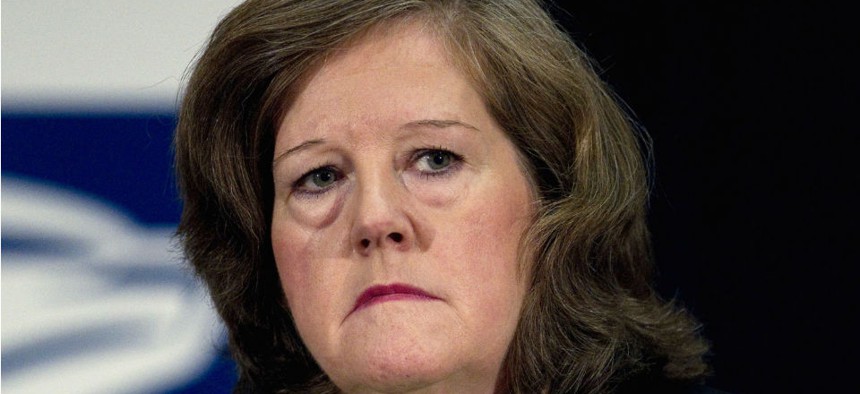As New Postal Leader Takes Charge, Obama Calls for Major USPS Reforms
Swearing in of postmaster general coincides with Obama's latest plan for an overhaul.
President Obama renewed his longstanding call to overhaul the U.S. Postal Service in his fiscal 2016 budget, saying the agency must be reformed to ensure its future viability.
Just one day after the Postal Service swore in its new postmaster general -- Megan Brennan -- Obama called for sweeping changes to modernize the cash-strapped agency, which the White House said would save a total of $36 billion over 11 years. Obama’s recommendations borrowed from recent legislative proposals that have failed to make their way through Congress, pulling no punches on the most controversial elements of postal reform.
Obama proposed the Postal Service cut Saturday mail delivery after volume declines to a level the White House expects USPS to hit in late 2018, a structure similar to the one put forward last Congress by Sen. Tom Carper, D-Del., and former Sen. Tom Coburn, R-Okla. The president’s plan would also allow USPS to phase out to-the-door delivery in favor of centralized or curbside delivery, while codifying the current policy of not closing rural post offices.
The White House pitched increasing revenue by providing postal management with more flexibility in creating new business opportunities, as well as boosting cooperation with state and local governments to offer services at post offices. Additionally, the budget plan called for making permanent the emergency price increase set to expire this year.
Obama also proposed restructuring the Postal Service’s requirement to prefund the health care of retirees. His plan would defer the fixed payments due in 2015 and 2016. Those payments would then be restructured into a 40-year amortization schedule starting in 2017. The proposal would provide more than $13 billion in relief to USPS through 2016.
Postal Service officials and some lawmakers have sought a much more aggressive approach to addressing the retiree health care issue, calling for a requirement that eligible retirees use Medicare as their primary health care provider.
The White House changed the language on modifying the delivery schedule, after calling for an immediate transition to five-day delivery in its fiscal 2015 blueprint. That proposal, the phasing out of door delivery “where appropriate” and making permanent the controversial “exigent” rate increase have proved major sticking points in Congress. Former House Oversight and Government Reform Committee Chairman Rep. Darrell Issa, R-Calif., attempted to mimic Obama’s fiscal 2015 proposal in legislation last year. The measure cleared Issa’s panel along party lines but never received a full vote on the House floor.
The proposed 2016 budget would return to USPS any surplus payments it has made to the Office of Personnel Management for USPS’ share of the Federal Employees Retirement System. The Postal Service has complained that the lack of a USPS-specific calculation for those costs has led to significant overpayment, which the White House estimated at $1.5 billion. The White House called on OPM to create a new postal formula for the payments moving forward.
The Obama administration has included similar postal reform measures in previous budgets, though the president tweaked his 2016 plan to mirror some of the developments in Congress.
Also on Monday, newly sworn in Postmaster General Brennan sent a letter to employees, praising their dedication and promising a future “filled with opportunity.”
“We have a lot of momentum as an organization today,” Brennan wrote, “despite our financial challenges. We continue to take prudent steps to bring our costs and revenues into better alignment. However, the way we are structured today and the way we serve the public today will not be adequate to fully meet the demands of tomorrow's marketplace.”
Cuts will be among the necessary changes, she said. Or, put another way, will help create “the most efficient and productive network to support our growth in products.” Reforms will also include, however, more investments, faster innovation and greater empowerment of employees.
NEXT STORY: Is Strategic Foresight an Ethical Imperative?




